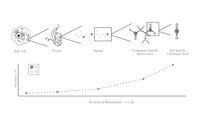
Photo from wikipedia
With the advent of new experimental techniques, measurements of individual, per-position, vapor pressure isotope effects (VPIEs) became possible. Frequently, they are in opposite directions (larger and smaller than unity), leading… Click to show full abstract
With the advent of new experimental techniques, measurements of individual, per-position, vapor pressure isotope effects (VPIEs) became possible. Frequently, they are in opposite directions (larger and smaller than unity), leading to the cancellation when only bulk values are determined. This progress has not been yet paralleled by the theoretical description of phase change processes that would allow for computational prediction of the values of these isotope effects. Herein, we present the first computational protocol that allowed us to predict carbon VPIEs for ethanol—the molecule of great importance in authentication protocols that rely on the precise information about position-specific isotopic composition. Only the model comprising explicit treatment of the surrounding first-shell molecules provided good agreement with the measured values of isotope effects. Additionally, we find that the internal vibrations of molecules of the model to predict isotope effects work better than the entire set of normal modes of the system.
Journal Title: ACS Omega
Year Published: 2020
Link to full text (if available)
Share on Social Media: Sign Up to like & get
recommendations!